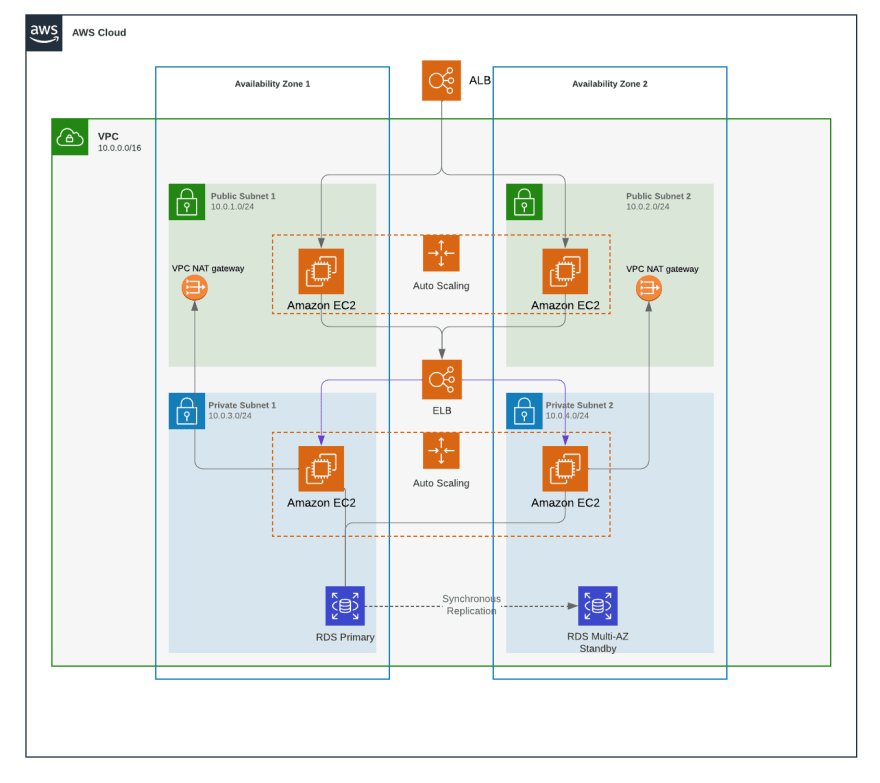AWS 3 Tier Architecture
Architecture Flow
- User → Internet-Facing ALB → Public-ASG (Web Tier) → Private-ASG (App Tier) → RDS (DB Tier).
- S3 and Lambda integrated for storage and serverless workflows.
- SNS and CloudWatch for alerts and monitoring.
Demo video:
Step-by-Step Guide to AWS 3-Tier Architecture Implementation
1. Project Setup & VPC Configuration
- Created a VPC (Virtual Private Cloud) to isolate resources.
- Designed subnets:
- Public subnets (for web tier).
- Private subnets (for application tier and database tier).
- Configured route tables, internet gateways, and NAT gateways for connectivity.
2. Security Groups Configuration
- Public-SG:
- Allowed inbound traffic from
0.0.0.0/0(internet) for HTTP/HTTPS access.
- Allowed inbound traffic from
- Private-SG:
- Restricted inbound traffic to only instances associated with Public-SG.
- RDS-SG:
- Allowed access exclusively from Private-SG for database security.
3. RDS Subnet Group Setup
- Created a DB subnet group for Amazon RDS.
- Assigned private subnets to the subnet group to host the database tier (e.g., MySQL/PostgreSQL).
4. Auto Scaling Groups (ASG)
- Public-ASG:
- Launched EC2 instances in public subnets (web tier).
- Configured scaling policies based on CPU/memory usage.
- Private-ASG:
- Launched EC2 instances in private subnets (application tier).
- Ensured instances are only accessible via Public-SG.
5. Load Balancers & Target Groups
- Internet-Facing Application Load Balancer (ALB):
- Deployed in public subnets.
- Forwarded traffic to Public-ASG instances via target groups.
- Internal Load Balancer (optional):
- Used for communication between application tier (private) and database tier.
6. Web Application Deployment
- Hosted a website on Public-ASG instances.
- Validated load balancing by refreshing instances and confirming traffic distribution.
7. Accessing Private Resources
- Bastion Host:
- Used a public EC2 instance (in Public-SG) to SSH into private instances (Private-SG).
- RDS Connection:
- Accessed the database from the application tier (private instances).
- S3 Integration:
- Uploaded
live_demo.txtto an S3 bucket from the public server.
- Uploaded
8. S3, RDS, and SNS Setup
- S3 Bucket:
- Created for static assets or file storage.
- RDS Database:
- Configured a relational database (e.g., MySQL) in the private subnet group.
- SNS Notifications:
- Sent alerts (e.g., scaling events) to a registered email via Amazon SNS.
9. Serverless Components
- Lambda Function:
- Deployed for event-driven tasks (e.g., processing S3 uploads).
- SQS Queue:
- Used to decouple components (e.g., sending messages between services).
10. Monitoring & Logging
- CloudWatch Logs:
- Tracked metrics and logs for EC2, RDS, Lambda, and ASG.
Terraform Implementation
Highly Available AWS 3 Tier Terraform Template
1. Configure the AWS CLI
$ aws configure
AWS Access Key ID [****************MRAE]:
AWS Secret Access Key [****************6wNJ]:
2. Install and Validate Terraform
Install Terraform using your system’s package manager or download it from the official website.
Linux (Ubuntu/Debian):
sudo apt-get update && sudo apt-get install -y gnupg software-properties-common
wget -O- https://apt.releases.hashicorp.com/gpg | gpg --dearmor | sudo tee /usr/share/keyrings/hashicorp-archive-keyring.gpg
echo "deb [signed-by=/usr/share/keyrings/hashicorp-archive-keyring.gpg] https://apt.releases.hashicorp.com $(lsb_release -cs) main" | sudo tee /etc/apt/sources.list.d/hashicorp.list
sudo apt update && sudo apt install terraform
Validate Installation:
terraform -version
This should display the installed Terraform version (e.g., Terraform v1.5.7), confirming a successful installation.
3. Clone the Repo and cd
git clone https://github.com/rizvifazi/aws-ha-tf.git
4. Create a key pair named tf-keypair in your AWS account
- We are taking a manual approach to create the keys for our convenience.
- This key-pair will be used by the terraform script to create resources.
5. Execute terraform commands
# Intialises provider plugin and modules
terraform init
# Validates the configuration files
terraform validate
# Shows the execution plan
terraform plan
# Creates the infrastructure
terraform apply

